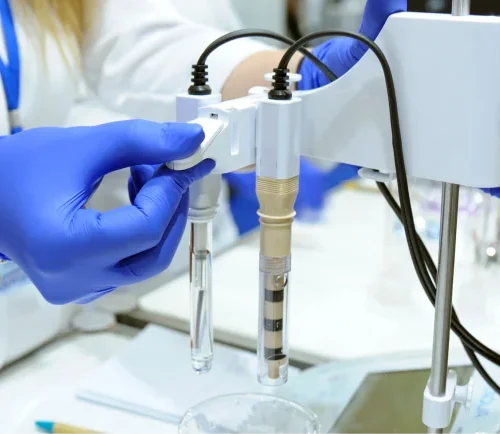pH Levels in Drinking Water
The Importance of Monitoring pH Levels in Drinking Water
The pH level of drinking water is a crucial factor that often goes unnoticed in everyday life. pH is a measure of how acidic or alkaline a solution is, and it plays a significant role in water quality. The pH scale ranges from 0 to 14, where 7 represents neutral water, values below 7 indicate acidic water, and values above 7 signify alkaline or basic water. Understanding and controlling the pH levels in drinking water are essential because pH imbalance can affect not only the taste of water but also its safety and suitability for consumption.
In this article, we’ll explore why it’s essential to monitor pH levels, where pH issues arise in drinking water, and the potential health risks involved. We’ll also guide you through detecting pH imbalance, how to address it, and the most common misconceptions about pH in drinking water.
01. What is pH Level?
pH is a measurement that indicates the acidity or alkalinity of a liquid. Specifically, it refers to the concentration of hydrogen ions in water. When the concentration of hydrogen ions is higher, the water becomes more acidic, lowering the pH. Conversely, when there are fewer hydrogen ions, the water becomes more alkaline, and the pH rises.
In drinking water, pH plays a crucial role in water’s taste, safety, and the overall health of the water supply. For instance, water with a low pH (below 6.5) can taste sour or metallic, while water with a high pH (above 8.5) can have a soapy or bitter taste.
The EPA recommends that drinking water should have a pH between 6.5 and 8.5 for safe consumption. Water outside this range may cause various issues, both in terms of health risks and plumbing concerns.
02. Where is the pH Level Found in Drinking Water?
The pH of water is influenced by both natural and human-made sources. Naturally, water picks up its pH from surrounding soil, rocks, and minerals. For instance, rainwater tends to be slightly acidic due to carbon dioxide in the atmosphere. Similarly, water that passes through limestone or other alkaline substances tends to become more alkaline.
Human activities, such as industrial discharges, agricultural runoff, and urban development, can also alter the pH of water supplies, leading to acidic or alkaline water that requires intervention.
03. Sources and Causes of pH Contamination in Water
Natural Sources
The natural pH of water can fluctuate due to environmental factors. For example, water passing through soil rich in minerals like limestone tends to have a higher pH, meaning it is more alkaline. On the other hand, water flowing through volcanic regions or picking up sulfur from nearby natural sources can become more acidic.
Human-Made Sources:
Water pH can also be affected by human activity. Agriculture, for example, often contributes to acidic water due to fertilizers, pesticides, and other chemicals that leach into groundwater. Industrial processes can also lead to water becoming acidic or alkaline, depending on the chemicals involved. For instance, factories releasing sulfur dioxide into the air can combine with water vapor to form sulfuric acid, which can lower the pH of rainwater and surface water.
In urban environments, the use of chemicals for treating water, such as chlorine, can also alter the pH level. Plumbing materials can further contribute to pH imbalance if old pipes made from metals like lead or copper leach into the water supply.
04. Health Effects of pH Levels in Water
Short-term Health Effects of pH Imbalance
When water is too acidic (pH below 6.5), it can irritate the skin, cause a metallic taste, and corrode plumbing fixtures. Drinking acidic water may also cause discomfort in the stomach, leading to symptoms like nausea, vomiting, or diarrhea. On the other hand, water with a high pH (above 8.5) can cause a soapy taste and may lead to gastrointestinal irritation, making it harder for the body to absorb nutrients properly.
Long-term Health Risks and Chronic Conditions
Over prolonged exposure to water with an extreme pH imbalance, such as acidic water that corrodes pipes, can lead to the leaching of harmful metals like lead or copper. These metals can be toxic and cause severe health problems, including neurological damage, kidney issues, and digestive problems. On the other hand, highly alkaline water can cause mineral imbalances and affect the body’s ability to absorb essential minerals like calcium and magnesium.
Vulnerable Populations
Certain populations, such as infants, the elderly, and individuals with weakened immune systems, are more vulnerable to the negative effects of poor water quality. Acidic or alkaline water can be particularly dangerous for infants, as their bodies are still developing and more sensitive to environmental factors. Additionally, for elderly individuals, who may have weaker digestive systems, consuming poor-quality water can exacerbate pre-existing health conditions.
05. How to Detect pH Levels in Water
Signs of pH Imbalance
You may notice a variety of signs that indicate your drinking water has an imbalance in its pH level:
- Acidic Water: The water may have a sour or metallic taste, and you might notice discoloration or rust stains around faucets and plumbing fixtures. Acidic water can corrode metal pipes and lead to the presence of harmful heavy metals like lead and copper in the water.
- Alkaline Water: Water that is too alkaline can leave a bitter taste, cause dry skin, and leave soap scum on dishes, bathtubs, and sinks. It may also result in the formation of scale buildup in appliances like water heaters.
Testing Methods
The most accurate way to test the pH of water is through laboratory testing. However, homeowners can also use pH test kits or digital pH meters, which are readily available. These tests will give you a clear picture of the pH range of your water and help you determine whether treatment is necessary.
Acceptable Limits
The EPA and World Health Organization (WHO) both recommend a pH range of 6.5 to 8.5 for drinking water. This range ensures that the water is safe for consumption and won’t lead to corrosion or scaling in plumbing systems.
06. How to Remove or Reduce pH Imbalance in Water
Effective Water Treatment Methods
When the pH level of your water is out of the recommended range, several water treatment options are available:
- pH Adjustment Using Chemicals: To neutralize acidic water, alkalinity increasers like lime or soda ash can be added. To reduce the pH in alkaline water, substances like citric acid or sulfuric acid may be used.
- Filtration Systems: Specialized water filters like reverse osmosis systems and alkaline filters are designed to balance pH levels. Reverse osmosis removes contaminants and can help bring the pH back to a neutral level. Alkaline filters raise the pH of water to make it more alkaline.
- Boiling: Boiling water may be effective in reducing the acidity slightly but is generally not a reliable method for significant pH adjustment.
Comparing Filtration Systems
- Reverse Osmosis: Highly effective at removing contaminants, including those affecting pH, providing pure water with a neutral pH.
- Activated Carbon Filters: Best for improving taste and removing chlorine but not highly effective for adjusting pH.
- Ion Exchange Systems: These are specifically designed to treat water hardness but can also affect pH by swapping ions like calcium and magnesium for sodium.
07. Common Misconceptions About pH Levels in Water
Myth
“Boiling water will correct pH imbalance.”
fact
Boiling water may help remove some acidic properties but does not effectively correct major pH imbalances. Specialized treatment methods are needed.
Myth
“Only extremely acidic or alkaline water is harmful.”
fact
While extreme pH values (below 6.5 or above 8.5) pose the greatest risk, even slight deviations from the neutral range can affect water quality, taste, and health.
Frequently Asked Questions (FAQs)
pH imbalances can occur naturally through soil, mineral content, or environmental pollution. Human activities like agriculture and industrial waste also contribute to pH fluctuations.
The EPA and WHO recommend a pH range of 6.5 to 8.5 for drinking water.
Signs include changes in taste, discoloration, and issues with plumbing. Testing with a pH kit or sending a sample to a lab will confirm the level.
Boiling may slightly lower acidity but doesn’t effectively address pH imbalances. Other treatment methods are recommended.
Conclusion
pH levels are a vital part of maintaining safe and healthy drinking water. Whether you’re dealing with acidic or alkaline water, it’s important to regularly test your water and treat it accordingly. By ensuring your water falls within the recommended pH range, you can protect your health, plumbing, and appliances. If you’re unsure about your water’s pH, testing and treatment are the best steps to ensure safety and quality.


